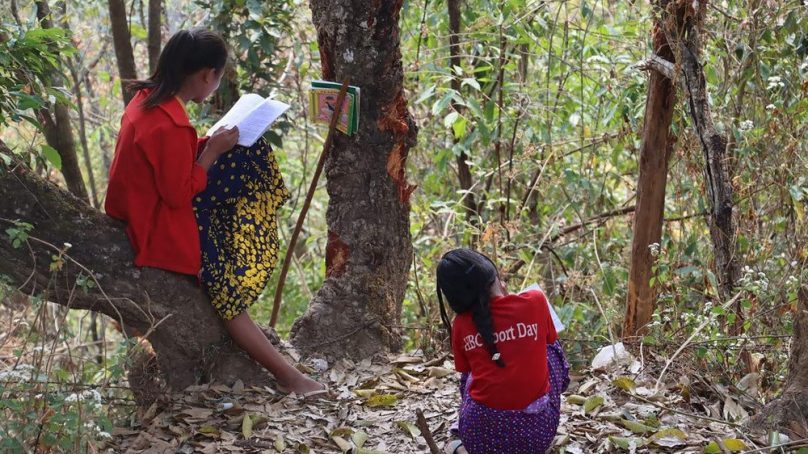
The Myanmar military has since last May retaliated against rising armed resistance in Karenni state with airstrikes and artillery fire, repeatedly targeting civilians and their homes and at times bombing displacement camps.
More than 170,000 people, or half of the state’s population, are now internally displaced, according to civil society groups.
Despite these adverse conditions, an education system run by the Karenni Education Department under an ethnic revolutionary organisation has expanded from 45 to 129 schools over the past year and is now serving more than 12,000 students, according to Maw Mimar, its director of border and IDP education.
She said that expanding needs have exceeded available resources, but that the schools are doing their best to adapt, including by teaching poems and songs where there are no schoolbooks and making their own tables and chairs out of bamboo.
The schools are also unable to provide a salary to teachers, who are mostly civil disobedience movement participants or recent graduates from Karenni community schools and ethnic colleges. Now, they are splitting their time between school and income-generating activities like farming and raising chickens and pigs, said Mimar.
On top of these challenges, facilities are limited. Some classes are running in former government schools the military can no longer access, and others are being taught in churches. However, many of these buildings are now housing IDPs, so 12 schools are running outdoors.
“We usually teach [students] under the trees or in nearby bamboo groves, where we think it’s safe,” said Mimar. “When it rains, we have to stop teaching.”
Communities in Chin State, which has seen intense fighting and military attacks since last April, were among the first to establish new school systems outside of the military administration last October. According to Salai Sucia*, a civil society worker involved in coordinating education initiatives in southern Chin State, more than 170 schools are now running in Mindat and Kanpetlet townships.
Educators at the new schools in Chin are using a hybrid curriculum that incorporates elements of the former government curriculum and lessons in students’ ethnic languages, said Salai Sucia.
But these new schools are facing immense challenges, many of them similar to those faced in Karenni State. “IDPs are staying in the school buildings, so we cannot teach there; we teach outside under temporary tents made of tarpaulin,” said Salai Cross Thang, education committee chairperson in Thantlang township. “Most of the teachers are young people, so they depend on their parents to do this volunteer work.”
The military has also systematically shut down the internet in embattled areas across the country, including in Chin State where most townships have lacked connectivity since September. A local media post from June shows educators in Mindat township participating in an online training from the top of a hill in order to get a signal, their phones propped up by stands of twigs.
Myanmar’s northwestern Sagaing region has suffered intense violence over the past year, as the military responds to armed resistance in the region by systematically burning villages and killing resistance fighters and civilians alike. But even as the crisis continues, township education boards under the National Unity Government have opened hundreds of schools.
In Kani township, where 148 schools are now running, teachers and students regularly hide in the forest for days or weeks at a time. “We are often attacked by military forces, so we have to flee often, said Myat Moe*, a teacher. “It hinders the ability to catch up after two years of school closures.”
Still, she and other educators are trying to continue providing instruction as much as they can. “While we are fleeing, we cannot teach formally; we can only teach stories and poems to younger children. After the soldiers leave, sometimes we substitute the days that they missed,” said Myat Moe.
The need to earn an income has also shortened school hours in Kani, where not only teachers but also students are working – including Myat Moe’s 16-year-old niece Htin Htin*, who rolls cheroots. At 400 kyats ($0.22) per 100 cigars, she can earn around 50 cents for a half-day of work. It is just enough to buy two notebooks, whose cost has doubled since the coup. “Although I want to do classwork and homework, I cannot do much because I have to earn an income too,” said Htin Htin.
Htin Htin is also distracted by the war. “I don’t feel safe at school. It is worse when military helicopters or fighter jets fly very low,” she said. “We always worry that soldiers will burn our house when they attack our village, so whenever we run I need to pack my books and other valuable things.”
Still, Htin Htin is determined to continue studying. “I believe that I need to be educated to resist this kind of oppression,” she said.
- The New Humanitarian report











